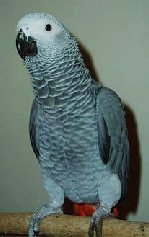So many myths surround this sensitive and intelligent companion bird. Some of these myths have assumed the status of fact by virtue of repetition, but repetition does not make them true. Some of the most common myths are “Greys are clumsy”, “Greys need more calcium”, “Greys pluck”, “Greys are one person birds” and “Greys are shy”. Nothing could be further from the truth.
MYTH IV – AFRICAN GREYS NEED MORE CALCIUM

Calcium plays a role in blood coagulation, maintains normal heart rhythm, transmits nerve impulses, calcifies egg shells, contracts the uterus during egg laying, and activates several enzyme systems. Seizures, as well as leg paralysis, have been associated with low blood calcium. Sudden collapse or fainting is characteristic of advanced calcium deficiency in Greys. Of all the species, Greys are most likely to suffer seizures from low blood calcium.
Anecdotal stories suggest some feather plucking may be caused by inadequate blood calcium levels.
Excessive levels of blood calcium can cause very serious and life threatening renal problems – mineralization of the kidneys and the renal tubes.
Be very careful with calcium supplements. Indiscriminate and excessive use of these supplements is dangerous and could become life threatening. The only time a calcium supplement should be given to a companion bird is after an abnormally low blood level is diagnosed and an avian vet prescribes supplementation.
The best way to prevent problems is to have a blood calcium level test done at the annual exam and to take your bird to the vet immediately at the first sign of illness. Since birds hide symptoms of illness, by the time there are symptoms (of whatever disease process), they are very sick indeed.
If a Grey is on a pellet-based varied diet – and such a diet may include high calcium foods such as almonds, low fat cheese, yogurt or veggies – he should not be given supplements unless prescribed by an avian vet. It is very important that a blood calcium test be performed at each annual exam, since calcium levels can change over time. Young birds will typically have a lower concentration than older companion birds.
A list of foods, showing the amount of calcium and phosphorus they contain, can be found in the article “Calcium, Phosphorus & Vitamin D3 in Your Bird’s Diet” at https://birdsnways.com/calcium-phosphorus-vitamin-d3/. The article also includes sources of Vitamin D3 and explains how calcium, phosphorus and Vitamin D3 must be balanced to ensure absorption and proper health.
A ratio of 2:1 calcium to available phosphorus in the diet, plus adequate Vitamin D, is recommended to ensure the proper amount of absorption of calcium by the body. If the bird is on a pelleted diet, a Vitamin D source is typically available. Vitamin D3 has the potential for toxicity and great caution is recommended when using a supplement that contains Vitamin D. Vitamin D3 is produced exclusively in the bird’s body and is 30 to 40 times more potent than Vitamin D2 (a plant derivative) Ref. Avian Medicine page 83. Soft tissue mineralization, especially of the kidneys, is one of the toxic effects of excessive Vitamin D3. Ref. Avian Medicine pages 82, 84. Species susceptibility to toxic overdoses varies as does susceptibility by sex.
Do not give your Grey pellets with added calcium or a calcium supplement unless it is medically necessary. Unnecessary and unneeded over-supplementation can lead to serious health complications – in companion Greys and in other birds.
| OTHER MYTHS ABOUT GREYS | |
|---|---|
| Myth I – Greys Are Clumsy | Myth III – Greys Are One-Person Birds |
| Myth II – Greys Are Pluckers | |

